Back in the office
I’m back at the West Chicago headquarters after a week in California, covering the Spring Trials with fellow editors Jen Zurko and Ellen Wells. Chances are you followed our adventures on our daily Acres of buZZ! newsletter and YouTube videos. If not, you can find all six newsletters at www.springtrials.com and all 35 videos in our 2019 Spring Trials playlist HERE. This is the first year we managed to post all our videos during the actual event (videographer extraordinaire Jen Zurko has become a master of Final Cut Pro).
In our daily coverage we focused primarily on the new and noteworthy varieties. I’ll take this edition of AO to share some of my overall observations, a few favorite intros, and a bit of the news that came out of the Six-day-long event.
Most important: IDM-resistant impatiens
The launches of Beacon by PanAmerican Seed and Imara XDR by Syngenta were not surprises. I’ve covered the development of both breakthrough varieties for months; in fact, Beacon made the cover of GrowerTalks in March of 2018. But that in no way lessens the importance of these two varieties to the industry, which lost an estimated 40% or more of worldwide impatiens sales to the disease.
What’s to choose between the two of them? Well, Imara is available globally as you read this, while Beacon is only being released in select IDM-impacted markets such as Florida and the East Coast, the UK, South Africa and Australia. It will see a full global rollout in 2020. Color-wise, Imara has a few more, including a bicolor. Habit-wise, I noted in the Costa Season Premier trial that Beacon looked a bit more uniform across the series; in fact, looking at photos of Beacon alongside Super Elfin, few can tell which is which (until Super Elfin succumbs to IDM, that is).
PanAmerican did manage to get some Imara seed, and they had those plants in an IDM-inoculated comparison trial alongside Beacon and Super Elfin. It was hard to miss that Beacon seemed the most vigorous of the three. Imara was more compact (genetics, or an effect of disease?) and had more yellow leaves, while the Super Elfin was dead or dying.

At Syngenta, they did a similar IDM-inoculated trial, but without any samples of Beacon to compare against. In their case, Imara (below, back row) looked very good compared to the unnamed susceptible variety. I should note that Syngenta recommends growers and landscapers continue their preventative spray regimes against IDM. To not do so would be “irresponsible,” they say.
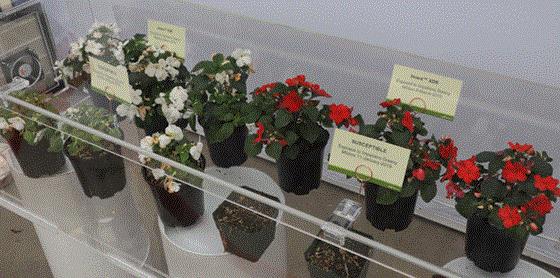
To their credit, neither company spoke negatively about the competition, instead only touting what they knew about their own genetics. And both companies say there’s plenty of room in the marketplace for both.
At another stop that breeds impatiens, they said they are looking hard at finding their own IDM-resistant variety. I asked if there was any discussion behind the scenes with Syngenta or PanAmerican about licensing their breakthroughs. The answer was a quick, “Of course!”
As to the $64 question of whether either or both will help bring back impatiens, we’ll have to see how they perform for the end consumer.

Don’t forget Cora XDR
I do want to mention another very popular variety, Cora vinca, which has displayed proven disease resistance (aerial phytophthora) ever since its introduction by Goldsmith Seeds in 2007. Not resting on their laurels, Syngenta has continued development of Cora, upgrading it to “XDR” (extra disease resistance) status with resistance to an additional dozen or so strains of aerial phytophthora.
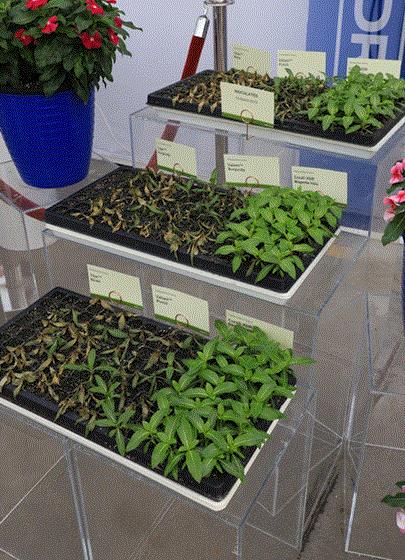
This trial shows Cora XDR (right) against Titan (left) and Valiant (center).
By the way, I should explain that to achieve XDR status, a Syngenta variety must 1) exhibit strong genetics even under disease pressure, 2) be rigorously tested at multiple locations and 3) be verified by third-party, independent researchers.
Some other noteworthy intros
It was a quiet year by any standard for introductions. But that’s not to say there weren’t some very nice and noteworthy intros—just none (other than the two impatiens above) that will change the industry. Here are five of my personal favorites from the week:
Betulia begonias (Ball Ingenuity). A compact hiemalis series that seem tough as nails. I think they’ll show nicely at retail.

Tall, Dark and Handsome (Westhoff). Actually, these are bred by Charles Valin of Valin Genetics in the UK and licensed to Westhoff by PlantHaven (yes, this business continues to inspire strange bedfellows). I like them because I’ve always admired the impact of “Pillar”-style geraniums since Oglevee launched the category decades ago. These sport dark foliage and four flower colors. A great premium patio item.
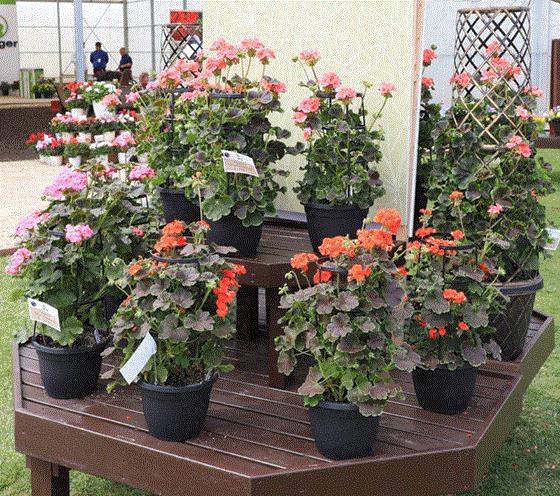
Noteworthy (continued)
Perennials in Basewell (Dümmen Orange). As the industry works to gain efficiency through automation, it’s worth mentioning Dümmen’s Basewell product as it’s the first method we’ve found for shipping a rooted cutting into the U.S. from offshore. Basewell takes advantage of the Visser AutoStix strip, in which they stick cuttings and then root them at their Oro Farms facility in Guatemala. The rooted cuttings are then shipped to you in special moisture-holding packaging.
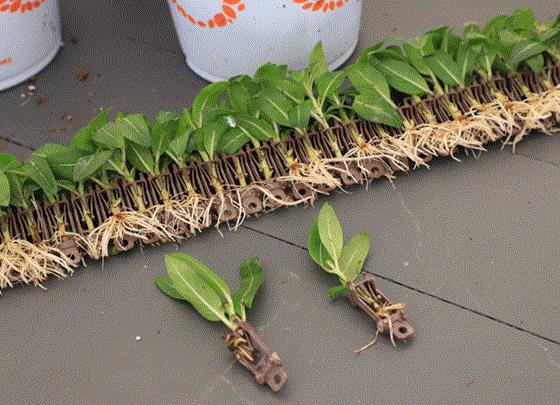
The best part is, you don’t have to have an AutoStix to take advantage of Basewell: They ship both strips and singulated cartridges, which can easily be hand-planted. Plus, nearly all of Dümmen’s annual line, plus some 120 varieties of perennial, are available in Basewell.
SunPatiens Compact Orchid Blush (Sakata). Seems like just another boring color addition, doesn’t it? But we were told that Sakata’s breeders have found a drought-tolerant impatiens species in Indonesia, and they’ve brought those genetics into the this introduction. Eventually, all SunPatiens will carry the genetics. Does it work? Is it more drought tolerant than the rest of the series, or other similar interspecific impatiens? We’ll have to see.
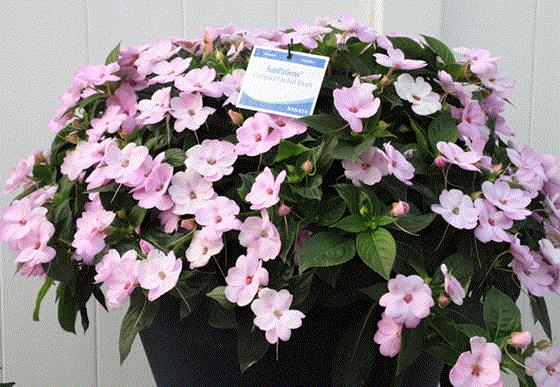
Pentas Sunstar (Proven Winners). The first pentas in the brand, and a good-looking one for hot climates, where pentas is a staple summertime annual. Being vegetative, they’re “big and beefy. And they’re said to work well as a regular spring (May) annual, too, not just as a summertime fill-in. Comes in four colors.


Classic Caladiums – which way up?
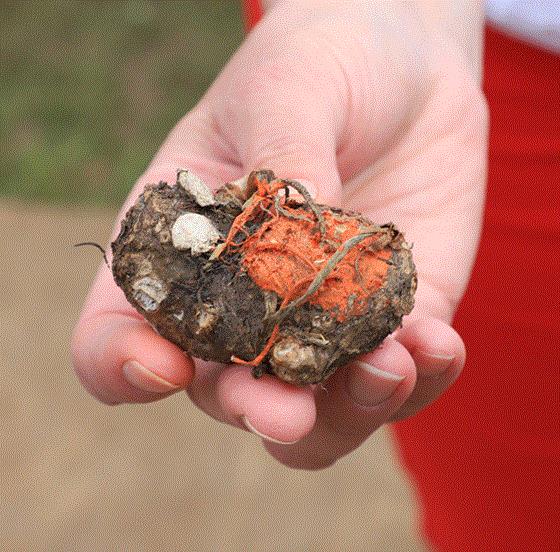
I’m an admirer of simple, forehead-slap-inducing “why-didn’t-I-think-of-that?” solutions. Here’s one by Classic Caladiums (now available through Proven Winners) to help employees know which side goes up when planting. According to Abbott IPCO’s Nelson Darden, one large grower told him it takes his crew three times longer to plant caladiums than any other bulb, because workers (especially new ones), can’t easily tell which side is up. Now, thanks to this simple spot of paint, they can.
News from Trials
Suntory’s new president. Meet Taizo Chinju, the new president of Suntory Flowers, effective April 1. He’s been with Suntory Flowers since 2004, and in 2013 became managing director of international business for both bedding plants and cut flowers (I didn’t know Suntory had a cut flower division). Taizo says the breeding and marketing teams “drive innovation by embracing the spirit of Yatte Minahare!—which means go for it!”

Florist, HilverdaKooij merger. Florist you know from our annual coverage of their gerbera trials—in fact, gerberas is all they do. HilverdaKooij breeds dianthus, limonium, alstroemeria and hellebores, among other garden plants, making for a good partnership. The new company will be called HilverdaFlorist. Since both are based in De Kwakel, the Netherlands, it will be easy to select a home base.
Syngenta and Varinova's Cyclamen. Syngenta is going to supplement their lines of cyclamen with those of Dutch specialist Varinova through an exclusive deal. Syngenta is starting with two series, Merita, an intermediate (4-in. to 5-in. pot), and Contiga, a standard (5-in. to 6 in. pot). They’ll no doubt pick up more as time goes on, and probably drop some of the older Goldsmith and Syngenta lines that haven’t kept up with the times.

In memoriam: Elisabeth “Jinx” Ecke
One can’t visit the California flower industry without recalling the Ecke family, the pioneer of poinsettias as a successful Christmas crop (and once an exhibitor at Spring Trials). That's why it was especially poignant to get the news on day two of Spring Trials from my friend Paul Ecke III that his mom had just passed away. Paul wrote that he had been visiting his mom at his sister, Liz’s, house. He left, and was halfway home, when Liz called to tell him that she had just passed. She’d been suffering from Alzheimer’s and was 87, so it wasn't completely unexpected.
What I was most curious about was how she got the nickname Jinx. I never knew her, but with a nickname like that, she had to be full of life and spirit. It turns out she gave it to herself.
Elisabeth grew up in Indiana during the Great Depression, and work was scarce. Her family decided to move to California in search of both a better life and better weather. On the drive out, 14-year-old Elisabeth spotted a movie marquee featuring a film starring Jinx Falkenberg. She reasoned that she needed a more exciting name than Elisabeth (or “Susie” as many in her family called her) in order to make an impression on her new classmates at La Jolla High School. She was apparently a hit from day one.
Jinx met Paul Ecke Jr. via a blind date set up by a sorority sister. Paul was a lieutenant in the Navy at the time. They hit it off, stayed in contact during her college years and his tour of duty, and were married in 1953.
 Jinx, circa 1964.
Jinx, circa 1964.
The rest of the Ecke family story is well known, with Jinx raising her three children, Paul III, Lizbeth and Sara, in the Ranch house on the family nursery property in Encinitas. Jinx was tremendously active in the San Diego area, serving countless organizations and earning numerous honors, including Distinguished Alumna of the Year at San Diego State.
A Celebration of Life will be held on May 26 at 2 p.m. at The Flower Fields in Carlsbad, California, with a reception immediately following. All who knew and loved Jinx are invited to come share in the memory of this wonderful woman.

Consumers want more colors
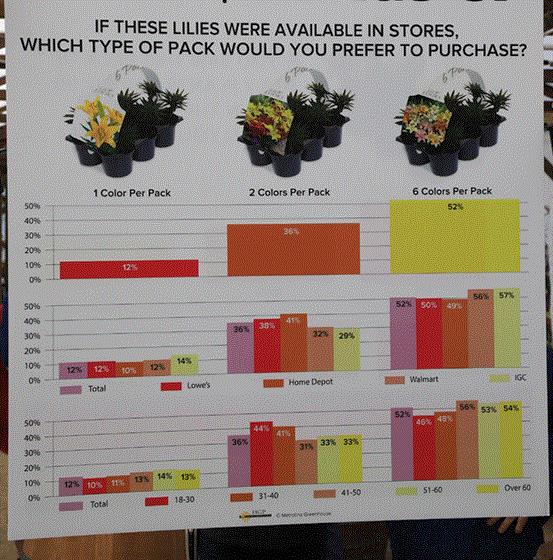
Lily breeder 2Plant International, which exhibited at the Windmill Nursery location, didn’t have any new genetics to show off, but they did offer up some stats from their recent participation in Metrolina Nursery’s big Home Garden Panel online focus group. 2Plant asked participants about six packs of lilies and whether they’d prefer one color of lily per pack, two colors per pack or six colors per pack. Regardless of age, respondents overwhelmingly (52%) chose the six-color six pack. Which, alas, is not how 2Plant has been doing it—they’ve been offering the one-color packs.
Makes you wonder if we’re giving customers enough variety in other products we sell them …
Finally …
You recall that back in February I appeared on a podcast hosted by none other than Peter Seabrook, the well-known and much-loved UK garden writer and commentator. Peter told me that he was planning a trip to the California Spring Trials—his first ever!—and darned if he didn’t make good on his promise. He rode along with the Ball Seed sales group, and we bumped into each other several times during the week.

Most flattering for me was when Peter asked if I’d record an interview with him and Anna Ball that he could use on his podcast. Well, rather than just record audio, I grabbed our camera and caught them both on videotape. It’s a quick watch, with Anna and Peter talking about getting young people involved in our industry, and the importance of the new Beacon impatiens. Watch it HERE.
See you next time,

Chris Beytes
Editor
GrowerTalks and Green Profit
This e-mail received by 23,552 loyal readers!
Thanks to my loyal sponsors, who help me reach the 23,552 readers of Acres Online in 66 countries. Want to be one of them (a sponsor, that is)? Give Paul Black a shout and he'll hook you up.